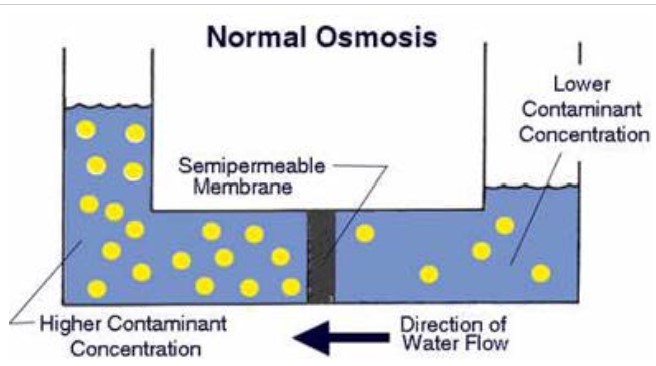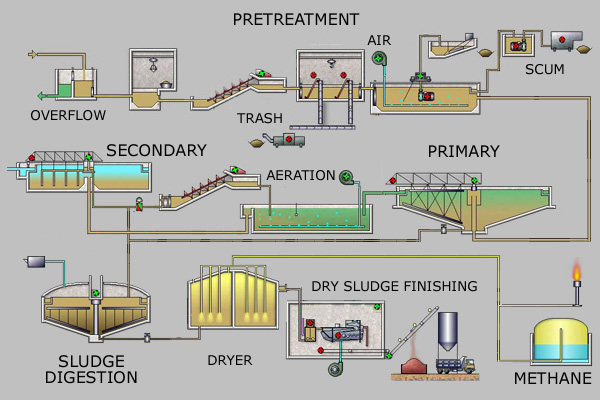14.7: Wastewater and Sewage Treatment
- Page ID
- 153881
\( \newcommand{\vecs}[1]{\overset { \scriptstyle \rightharpoonup} {\mathbf{#1}} } \)
\( \newcommand{\vecd}[1]{\overset{-\!-\!\rightharpoonup}{\vphantom{a}\smash {#1}}} \)
\( \newcommand{\id}{\mathrm{id}}\) \( \newcommand{\Span}{\mathrm{span}}\)
( \newcommand{\kernel}{\mathrm{null}\,}\) \( \newcommand{\range}{\mathrm{range}\,}\)
\( \newcommand{\RealPart}{\mathrm{Re}}\) \( \newcommand{\ImaginaryPart}{\mathrm{Im}}\)
\( \newcommand{\Argument}{\mathrm{Arg}}\) \( \newcommand{\norm}[1]{\| #1 \|}\)
\( \newcommand{\inner}[2]{\langle #1, #2 \rangle}\)
\( \newcommand{\Span}{\mathrm{span}}\)
\( \newcommand{\id}{\mathrm{id}}\)
\( \newcommand{\Span}{\mathrm{span}}\)
\( \newcommand{\kernel}{\mathrm{null}\,}\)
\( \newcommand{\range}{\mathrm{range}\,}\)
\( \newcommand{\RealPart}{\mathrm{Re}}\)
\( \newcommand{\ImaginaryPart}{\mathrm{Im}}\)
\( \newcommand{\Argument}{\mathrm{Arg}}\)
\( \newcommand{\norm}[1]{\| #1 \|}\)
\( \newcommand{\inner}[2]{\langle #1, #2 \rangle}\)
\( \newcommand{\Span}{\mathrm{span}}\) \( \newcommand{\AA}{\unicode[.8,0]{x212B}}\)
\( \newcommand{\vectorA}[1]{\vec{#1}} % arrow\)
\( \newcommand{\vectorAt}[1]{\vec{\text{#1}}} % arrow\)
\( \newcommand{\vectorB}[1]{\overset { \scriptstyle \rightharpoonup} {\mathbf{#1}} } \)
\( \newcommand{\vectorC}[1]{\textbf{#1}} \)
\( \newcommand{\vectorD}[1]{\overrightarrow{#1}} \)
\( \newcommand{\vectorDt}[1]{\overrightarrow{\text{#1}}} \)
\( \newcommand{\vectE}[1]{\overset{-\!-\!\rightharpoonup}{\vphantom{a}\smash{\mathbf {#1}}}} \)
\( \newcommand{\vecs}[1]{\overset { \scriptstyle \rightharpoonup} {\mathbf{#1}} } \)
\( \newcommand{\vecd}[1]{\overset{-\!-\!\rightharpoonup}{\vphantom{a}\smash {#1}}} \)
\(\newcommand{\avec}{\mathbf a}\) \(\newcommand{\bvec}{\mathbf b}\) \(\newcommand{\cvec}{\mathbf c}\) \(\newcommand{\dvec}{\mathbf d}\) \(\newcommand{\dtil}{\widetilde{\mathbf d}}\) \(\newcommand{\evec}{\mathbf e}\) \(\newcommand{\fvec}{\mathbf f}\) \(\newcommand{\nvec}{\mathbf n}\) \(\newcommand{\pvec}{\mathbf p}\) \(\newcommand{\qvec}{\mathbf q}\) \(\newcommand{\svec}{\mathbf s}\) \(\newcommand{\tvec}{\mathbf t}\) \(\newcommand{\uvec}{\mathbf u}\) \(\newcommand{\vvec}{\mathbf v}\) \(\newcommand{\wvec}{\mathbf w}\) \(\newcommand{\xvec}{\mathbf x}\) \(\newcommand{\yvec}{\mathbf y}\) \(\newcommand{\zvec}{\mathbf z}\) \(\newcommand{\rvec}{\mathbf r}\) \(\newcommand{\mvec}{\mathbf m}\) \(\newcommand{\zerovec}{\mathbf 0}\) \(\newcommand{\onevec}{\mathbf 1}\) \(\newcommand{\real}{\mathbb R}\) \(\newcommand{\twovec}[2]{\left[\begin{array}{r}#1 \\ #2 \end{array}\right]}\) \(\newcommand{\ctwovec}[2]{\left[\begin{array}{c}#1 \\ #2 \end{array}\right]}\) \(\newcommand{\threevec}[3]{\left[\begin{array}{r}#1 \\ #2 \\ #3 \end{array}\right]}\) \(\newcommand{\cthreevec}[3]{\left[\begin{array}{c}#1 \\ #2 \\ #3 \end{array}\right]}\) \(\newcommand{\fourvec}[4]{\left[\begin{array}{r}#1 \\ #2 \\ #3 \\ #4 \end{array}\right]}\) \(\newcommand{\cfourvec}[4]{\left[\begin{array}{c}#1 \\ #2 \\ #3 \\ #4 \end{array}\right]}\) \(\newcommand{\fivevec}[5]{\left[\begin{array}{r}#1 \\ #2 \\ #3 \\ #4 \\ #5 \\ \end{array}\right]}\) \(\newcommand{\cfivevec}[5]{\left[\begin{array}{c}#1 \\ #2 \\ #3 \\ #4 \\ #5 \\ \end{array}\right]}\) \(\newcommand{\mattwo}[4]{\left[\begin{array}{rr}#1 \amp #2 \\ #3 \amp #4 \\ \end{array}\right]}\) \(\newcommand{\laspan}[1]{\text{Span}\{#1\}}\) \(\newcommand{\bcal}{\cal B}\) \(\newcommand{\ccal}{\cal C}\) \(\newcommand{\scal}{\cal S}\) \(\newcommand{\wcal}{\cal W}\) \(\newcommand{\ecal}{\cal E}\) \(\newcommand{\coords}[2]{\left\{#1\right\}_{#2}}\) \(\newcommand{\gray}[1]{\color{gray}{#1}}\) \(\newcommand{\lgray}[1]{\color{lightgray}{#1}}\) \(\newcommand{\rank}{\operatorname{rank}}\) \(\newcommand{\row}{\text{Row}}\) \(\newcommand{\col}{\text{Col}}\) \(\renewcommand{\row}{\text{Row}}\) \(\newcommand{\nul}{\text{Nul}}\) \(\newcommand{\var}{\text{Var}}\) \(\newcommand{\corr}{\text{corr}}\) \(\newcommand{\len}[1]{\left|#1\right|}\) \(\newcommand{\bbar}{\overline{\bvec}}\) \(\newcommand{\bhat}{\widehat{\bvec}}\) \(\newcommand{\bperp}{\bvec^\perp}\) \(\newcommand{\xhat}{\widehat{\xvec}}\) \(\newcommand{\vhat}{\widehat{\vvec}}\) \(\newcommand{\uhat}{\widehat{\uvec}}\) \(\newcommand{\what}{\widehat{\wvec}}\) \(\newcommand{\Sighat}{\widehat{\Sigma}}\) \(\newcommand{\lt}{<}\) \(\newcommand{\gt}{>}\) \(\newcommand{\amp}{&}\) \(\definecolor{fillinmathshade}{gray}{0.9}\)- Explain the major steps in wastewater treatment.
- List the different uses of reclaimed water.
Wastewater and sewage is treated in three phases: primary (solid removal), secondary (bacterial decomposition), and tertiary (extra filtration).
Sewage is generated by residential and industrial establishments. It includes household waste liquid from toilets, baths, showers, kitchens, sinks, and so forth that is disposed of via sewers. In many areas, sewage also includes liquid waste from industry and commerce. The separation and draining of household waste into greywater and blackwater is becoming more common in the developed world. Greywater is water generated from domestic activities such as laundry, dishwashing, and bathing, and can be reused more readily. Blackwater comes from toilets and contains human waste.
Figure \(\PageIndex{1}\) Diagram of Sewage Treatment Process: Sewage passes through primary, secondary, and tertiary treatment.
Primary Treatment
In primary treatment, sewage is stored in a basin where solids (sludge) can settle to the bottom and oil and lighter substances can rise to the top. These layers are then removed and then the remaining liquid can be sent to secondary treatment. Sewage sludge is treated in a separate process called sludge digestion.
Secondary Treatment
Secondary treatment removes dissolved and suspended biological matter, often using microorganisms in a controlled environment. Most secondary treatment systems use aerobic bacteria, which consume the organic components of the sewage (sugar, fat, and so on). Some systems use fixed film systems, where the bacteria grow on filters, and the water passes through them. Suspended growth systems use “activated” sludge, where decomposing bacteria are mixed directly into the sewage. Because oxygen is critical to bacterial growth, the sewage is often mixed with air to facilitate decomposition.
Tertiary Treatment
Tertiary treatment (sometimes called “effluent polishing”) is used to further clean water when it is being discharged into a sensitive ecosystem.
Several methods can be used to further disinfect and purify sewage beyond primary and secondary treatment.
Sand filtration, where water is passed through a sand filter, can be used to remove particulate matter.
Wastewater may still have high levels of nutrients such as nitrogen and phosphorus. These can disrupt the nutrient balance of aquatic ecosystems and cause algae blooms and excessive weed growth. Phosphorus can be removed biologically in a process called enhanced biological phosphorus removal. In this process, specific bacteria, called polyphosphate accumulate organisms that store phosphate in their tissue. When the biomass accumulated in these bacteria is separated from the treated water, these biosolids have a high fertilizer value. Nitrogen can also be removed using nitrifying bacteria.
Lagooning is another method for removing nutrients and waste from sewage. Water is stored in a lagoon and native plants, bacteria, algae, and small zooplankton filter nutrients and small particles from the water.
Treatment by activated carbon is mostly due to adsorption or absorption. When a chemical species is adhered to the surface of a solid, it is an adsorption. When partial chemical bonds are formed between adsorbed species or when the absorbate got into the channels of the solids, we call it absorption. However, these two terms are often used to mean the same, because to distinguish one from type from the other is very difficult.
Application of activated charcoal for the removal of undesirable order and taste in drinking water has been recognized at the dawn of civilization. Using bone char and charred vegetation, gravel, and sand for the filtration of water for domestic application has been practised for thousands of years. Charcoal absorbs many substances, ranging from colored organic particulates to inorganic metal ions. Charcoal has been used to remove the colour of raw sugar from various sources.
Filtration is the process of removing solids from a fluid by passing it through a porous medium. Coarse, medium, and fine porous media have been used depending on the requirement. The filter media are artificial membranes, nets, sand filter, and high technological filter systems. The choice of filters depends on the required filtering speed and the cleanness requirement. The flow required for filtration can be achieved using gravity or pressure. In pressure filtration, one side of the filter medium is at higher pressure than that of the other so that the filter plane has a pressure drop. Some portion of this filter type must be enclosed in a container.
When a compartment containing a dilute solution is connected to another compartment containing a concentrated solution by a semipermeable membrane, water molecules move from the dilute solution to concentrated solution. This phenomenon is called osmosis. By applying pressure in the higher concentration solution, water molecules migrate from a high concentration solution to a low concentration solution through a semipermeable membrane. This method is called reverse osmosis water filter system. In this technique, the membrane must be able to tolerate the high pressure, and prevent solute molecules to pass through. This technology certainly works, and it has been used to convert salt (ocean or sea) water into fresh water. With this technique, the water with higher concentration is discharged. Thus, this technology is costly in regions where the water cost is high.


Sludge Digestion
Sewage sludge scraped off the bottom of the settling tank during primary treatment is treated separately from wastewater. Sludge can be disposed of in several ways. First, it can be digested using bacteria; bacterial digestion can sometimes produce methane biogas, which can be used to generate electricity. Sludge can also be incinerated, or condensed, heated to disinfect it, and reused as fertilizer.
Uses of Reclaimed Wastewater
Water reclamation (also called wastewater reuse) is the process of converting wastewater into water that can be reused for other purposes. Reuse may include irrigation of gardens and agricultural fields or replenishing surface water and groundwater (i.e., groundwater recharge). Reused water may also be directed toward fulfilling certain needs in residences (e.g. toilet flushing), businesses, and industry, and could even be treated to reach drinking water standards. This last option is called either "direct potable reuse" or "indirect potable" reuse, depending on the approach used.
Reclaiming water for reuse applications instead of using freshwater supplies can be a water-saving measure. When used water is eventually discharged back into natural water sources, it can still have benefits to ecosystems, improving streamflow, nourishing plant life and recharging aquifers, as part of the natural water cycle.
Wastewater reuse is a long-established practice used for irrigation, especially in arid countries. Reusing wastewater as part of sustainable water management allows water to remain as an alternative water source for human activities. This can reduce scarcity and alleviate pressures on groundwater and other natural water bodies. Another potentially positive aspect is the nutrient content in the wastewater, which might reduce the need of other fertilizers.
Drawbacks or risks often mentioned include the content of potentially harmful substances such as bacteria, heavy metals or organic pollutants (including pharmaceuticals, personal care products and pesticides). Irrigation with wastewater can have both positive and negative effects on soil and plants, depending on the composition of the wastewater and on the soil or plant characteristics.

Most of the uses of water reclamation are non potable uses such as washing cars, flushing toilets, cooling water for power plants, concrete mixing, artificial lakes, irrigation for golf courses and public parks, and for hydraulic fracturing. Where applicable, systems run a dual piping system to keep the recycled water separate from the potable water.
The main reclaimed water applications in the world are shown below:
| Categories of use | Uses |
|---|---|
| Urban uses | Irrigation of public parks, sporting facilities, private gardens, roadsides; Street cleaning; Fire protection systems; Vehicle washing; Toilet flushing; Air conditioners; Dust control. |
| Agricultural uses | Food crops not commercially processed; Food crops commercially processed; Pasture for milking animals; Fodder; Fibre; Seed crops; Ornamental flowers; Orchards; Hydroponic culture; Aquaculture; Greenhouses; Viticulture. |
| Industrial uses | Processing water; Cooling water; Recirculating cooling towers; Washdown water; Washing aggregate; Making concrete; Soil compaction; Dust control. |
| Recreational uses | Golf course irrigation; Recreational impoundments with/without public access (e.g. fishing, boating, bathing); Aesthetic impoundments without public access; Snowmaking. |
| Environmental uses | Aquifer recharge; Wetlands; Marshes; Stream augmentation; Wildlife habitat; Silviculture. |
| Potable uses | Aquifer recharge for drinking water use; Augmentation of surface drinking water supplies; Treatment until drinking water quality. |
If it's good enough for astronauts...
Astronauts aboard the International Space Station drink reclaimed urine. (Credit: NASA)
In outer space, as on the International Space Station, water is at a premium and not a drop is to be wasted. Astronauts aboard the station must drink recycled water. Water from humidity in the air is condensed and used as drinking water, but American astronauts also drink recycled urine! You can imagine the urine, which is of course almost all water, would go through a rigorous purification process, but this just shows if the need exists, that the same water can serve valuable purposes over and over again.
Summary
- Wastewater treatment is a process used to remove from or and convert it into an that can be returned to the with minimum impact on the environment, or directly reused.
- In a wastewater treatment plant wastewater or sewage undergo primary,secondary, as well as tertiary treatments depending on the end use.
- Most of the uses of water reclamation are non potable uses such as washing cars, flushing toilets, cooling water for power plants, concrete mixing, artificial lakes, irrigation for golf courses and public parks, and for hydraulic fracturing
Contributors and Attributions
- Libretexts: Microbioloy (Boundless)
- USGS
Chung (Peter) Chieh (Professor Emeritus, Chemistry @ University of Waterloo)
- Wikipedia



